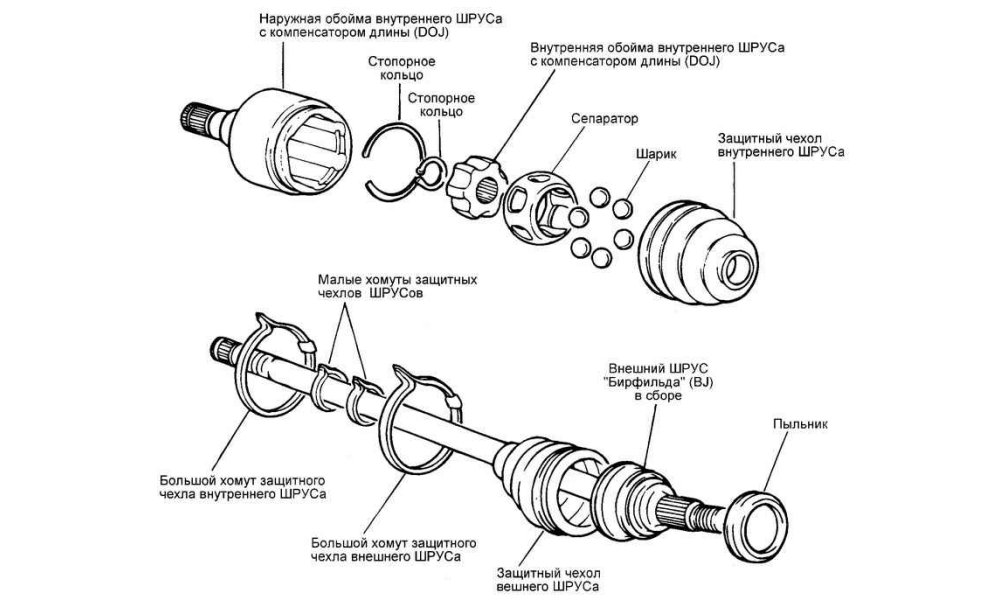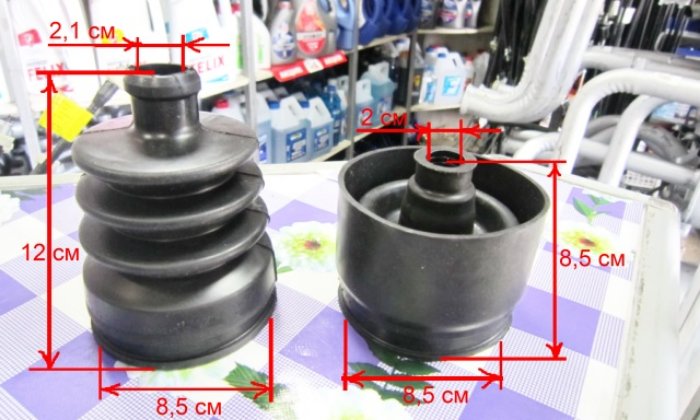Depending on the operating mode, sooner or later there comes a moment when, on a VAZ 21213 Niva car, a CV joint failure leads to its replacement. The catch is that these elements are not subject to repair and, in case of wear, are replaced with new ones after a breakdown. Diagnosing problems with the CV joint VAZ 21213-21214 (in the common people - grenades) is quite simple, but extending its service life is more difficult.
It just so happened that most motorists pay attention to any part of the car after it fails. A new CV joint is purchased and replaced, which takes time and significant funds. In fact, the angular velocity hinges installed in the Niva do not drift.
Unlike front-wheel drive cars VAZ 2110-2114, in the Niva, the torque is distributed to 4 wheels. This means that the load on the front wheel drive is half as much as in the same VAZ 2114. And if we theoretically assume that not a drop of abrasive dust and dirt gets inside the hinged mechanisms of the axle shafts, then the service life of the CV joint will be equal to the duration of the "life" of the auto. Of course, in real life this is impossible, and the Niva is designed for off-road driving.
It is quite possible to extend the operation of grenades as much as possible. To do this, you must regularly perform the following activities:
- Perform a visual inspection of the anthers covering the hinges. When the car is operated on an asphalt road, then an inspection should be carried out every 10-15 thousand km. When driving off-road or on unpaved and unpaved roads, grenade covers need to be inspected more often, especially after trips in difficult conditions.
- If you find the slightest damage to the anther, immediately replace it with a new one. This also applies to the clamps that hold the covers in place.
- During the replacement, remove the old grease from the Niva CV joint along with the dirt that has got in and apply a new one. The lubricant used is SHRUS-4, its amount for an external grenade is 40 cm 3, for an internal one - 80 cm 3.

If you pay attention to these elements, then they will quietly serve 150-200 thousand km. Otherwise, malfunctions may appear already in the first hundred thousand km.
Problem symptoms
If during the operation of the Niva car the following symptoms of a malfunction appear, then additional diagnostics should be carried out:
- while cornering, a characteristic crispy sound is heard from the front of the car, as if during operation, steel balls touch the body;
- the same, only instead of a crunch, a knock is heard, it can disappear during rectilinear movement;
- a constant crunch that does not disappear when driving in a straight line indicates wear on the internal grenade.
Remember that after the appearance of such noises on one side or both, it is impossible to immediately delay the repair. Otherwise, a faulty CV joint can do a lot of trouble right on the go. To make sure that the grenade is broken, you can check it in 2 ways:
- Choose a flat area so that there is enough space for the Niva to turn around. Make a few circles on it for and counterclockwise, turning the steering wheel all the way. Listen carefully for the sounds that come up. If they look like a crunch, go to part 2 of the diagnosis.
- Install the machine above the inspection hole and check for play in all 4 nodes by manually swinging and turning the axle shaft in different directions. A worn hinge will immediately make itself felt.

If at the same time it was found that the anther was damaged or water was flowing out of it, then the CV joint in this place must have become unusable.
Causes of rapid wear of the hinges
The main enemies of any hinged mechanisms are dust and dirt, which play the role of an abrasive and accelerate the wear of the grenade. It is worth the car owner to miss the damage to the elastic cover and drive for some time without replacing it, as the same dirt gets inside, which sooner or later will do its job, even if you change the boot.
There are other reasons leading to malfunction and replacement of elements:
- there is not enough lubrication in the mechanism or its quality leaves much to be desired;
- too aggressive driving on bad roads, constantly creating extreme loads on the CV joints;
- factory marriage in the details of the assembly.
Conclusion: most of the causes can be foreseen and prevented with the help of prevention, postponing the replacement of grenades indefinitely.
An exception is the situation when a factory defect is caught, but this happens quite rarely.
First you need to purchase a new part of good quality. At the same time, it is important not to confuse the CV joint for the Niva with the same one from the VAZ 2114 or another model of the "tenth" family. The nodes suitable for the VAZ 21213 have 24 splines and are designated by the following catalog numbers:
- internal ball for the right side - 2123-2215056;
- the same, tripoid - 2123-2215054;
- left inner tripoid and ball - 2123-2215055 and 2123-2215057, respectively;
- external grenade normal and under ABS - 2123-2215012 and 2123-2215012-10, respectively.
Products are sold complete with anthers, you need to purchase new clamps separately. You will have to devote enough time to complete the replacement, since the Niva transmission is more complicated and takes longer to disassemble than that of the VAZ 2110. There you will need to unscrew 2 ball bearings instead of one and press out the tie rod ball pin.
Before installing on a car, it is necessary to remove elastic covers from new products and check for lubrication. If necessary, add the required amount, and put the covers back and securely tighten with clamps. After installing new CV joints and assembling the car, it is recommended to drive out and check it in cornering, making sure that all extraneous sounds have disappeared.







